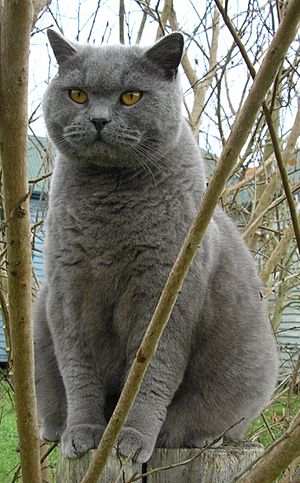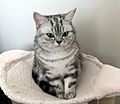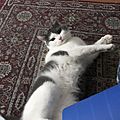British Shorthair facts for kids
Quick facts for kids British Shorthair |
|
|---|---|

Classic ‘British Blue’ Shorthair
|
|
| Origin | |
| Breed standards | |
| CFA | standard |
| FIFe | standard |
| TICA | standard |
| WCF | standard |
| FFE | standard |
| AACE | standard |
| ACF | standard |
| ACFA/CAA | standard |
| CCA-AFC | standard |
| Domestic cat (Felis catus) | |
The British Shorthair is a special type of cat that comes from Great Britain. It's known for its strong, stocky body, thick fur, and wide face. The most famous type is the "British Blue." This cat has a solid gray-blue coat, orange eyes, and a medium-sized tail. But British Shorthairs also come in many other colors and patterns, like tabby and colorpoint.
This breed is one of the oldest known cat breeds. In the UK, it's still the most popular purebred cat. About a quarter of all kittens registered there each year are British Shorthairs.
These cats look friendly and are usually calm. This makes them popular in movies and TV shows. The famous Cheshire Cat from Alice in Wonderland was even inspired by a British Shorthair!
Contents
History of the British Shorthair
The British Shorthair likely started way back in the first century AD. This makes it one of the oldest cat breeds we know about. The Romans brought these cats to Britain. They used them to keep their camps free of snakes, mice, and insects.
Over time, these Roman cats mixed with local wildcats. Their babies grew into large, strong cats with short, thick fur. This helped them handle the weather on the islands. Pictures from the past show that today's British Shorthair looks very much like these early cats.
How the Breed Became Popular
People started carefully breeding these cats in the 1800s. They especially wanted to develop the blue-gray type, called the "British Blue." Some people say a British artist named Harrison Weir was the first to think about making this a standard breed. Others believe a group of breeders worked on it together.
The new British Shorthair was shown at the very first cat show. Harrison Weir organized this show at the Crystal Palace in London in 1871. The breed became very popular right away.
Challenges and Comebacks
By the early 1900s, new breeds like the Persian became popular. The British Shorthair lost some of its fame. By World War I, there were very few purebred British Shorthairs left. To help the breed, breeders mixed Persians into their cat families. This mixing eventually led to the British Longhair breed.
After the war, breeders worked hard to bring the British Shorthair back. They even mixed in Russian Blue cats and the French Chartreux breed. The Chartreux looks a lot like the British Blue, even though they aren't related. By the late 1970s, the British Shorthair was officially recognized by major cat clubs. Today, it's once again the most popular purebred cat in the UK.
What British Shorthairs Look Like
Size and Features
The British Shorthair is a strong and large cat. They have a wide chest and thick, strong legs with round paws. Their tail is medium-length with a blunt tip. Their head is big and round, with a short nose and wide cheeks. Male cats often have very noticeable jowls (chubby cheeks!).
Their large, round eyes are usually a deep coppery orange in the British Blue type. Other colors can have different eye colors. Their ears are wide and set far apart.
Sometimes, people confuse the British Blue with the gray Scottish Fold. But the British Shorthair has pointy, triangle-shaped ears. The Scottish Fold has soft, folded ears.
Growing Up and Size Differences
These cats grow up slowly compared to most other breeds. They don't reach their full size until they are about three years old. Also, male and female British Shorthairs are quite different in size. Males usually weigh between 9 and 17 pounds (4 to 8 kg). Females are smaller, weighing about 7 to 12 pounds (3 to 5 kg).
Their Special Coat and Colors
The British Shorthair's fur is one of its most special features. It's very thick but doesn't have a soft undercoat. This makes the fur feel plush and firm, not fluffy. When the cat moves, the fur breaks apart in a unique way.
While the British Blue is the most famous, these cats come in many other colors and patterns. You can find them in black, blue, white, red, cream, silver, and golden. Newer colors include cinnamon and fawn. They can be solid colors, or have patterns like colorpoint, tabby, shaded, and bicolor. Many colors also come in tortoiseshell patterns.
The tabby patterns include Classic, Mackerel, Spotted, and Ticked. Other patterns include Tortoiseshell, Bi-Colour, Van patterns, Smoke, Tipped, and Colourpointed.
British Shorthair Personality
British Shorthairs are generally calm and easygoing cats. They aren't as active or playful as some other breeds. But they are sweet and very loyal to their owners. This makes them a favorite for animal trainers.
They usually get along well with other pets and children. They can handle some physical interaction. However, they generally don't like to be picked up or carried. These cats don't need much grooming. They are also happy living indoors. Just be careful with their diet, as they can gain weight easily.
They are quiet and watchful. If they trust you, they will follow you silently and stay nearby. British Shorthairs are not "lap cats." They prefer to sit next to you rather than on your lap. They like to keep their feet on the ground. They have soft voices and a moderate energy level. When you're not home, they will usually wait quietly for you to return.
Images for kids
See also
 In Spanish: British Shorthair para niños
In Spanish: British Shorthair para niños
















